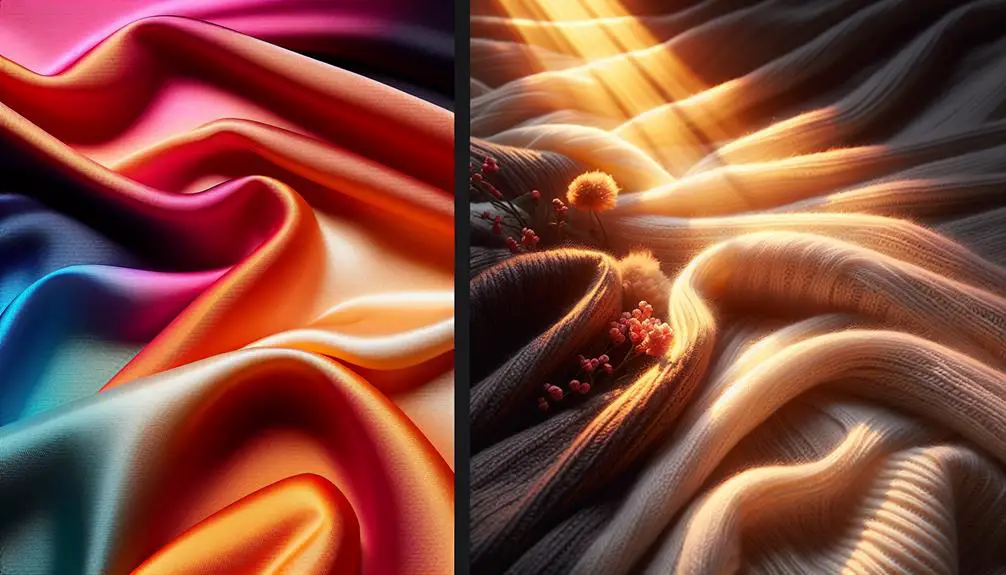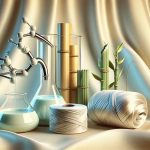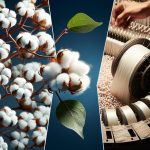Ever wondered if rayon's got an edge over cotton, or is it the other way around? I've been digging into this, considering how each fabric stacks up in terms of comfort, durability, and environmental impact. Rayon's silky texture and vibrant colors make it a standout, but cotton's breathability and natural softness are hard to beat. Plus, there's the whole debate about sustainability to consider. It's a lot to weigh up, and I'm leaning towards a favorite, but I'm curious about what you think. Let's unpack this together, shall we? There's plenty to ponder about what really makes one better than the other.
Table of Contents
Key Takeaways
- Cotton is stronger and more durable than rayon, especially when wet.
- Rayon offers a silkier texture and better drapability compared to cotton.
- Cotton is more environmentally friendly, with options like organic cotton reducing pesticide use.
- Rayon is more affordable but cotton's longevity may offer better value over time.
- Cotton is better for moisture management in humid conditions, while rayon is superior in moisture absorption.
Understanding Rayon
Rayon, a semi-synthetic fabric that hit the scene in the late 1800s, offers a silk-like feel without the hefty price tag. I've always been intrigued by how something not entirely natural can mimic one of the most luxurious materials out there – silk. The secret lies in its origin; it's made from processed cellulose, primarily sourced from wood or bamboo. This gives rayon that luxurious feel and silk-like texture we all love.
Diving deeper into its makeup, the production process of rayon is fascinating. It's not as straightforward as you might think. There's a whole lot of complex chemical treatments involved to transform plant-based cellulose into the soft, drapey fabric that ends up in our wardrobes. This process is key to why rayon holds color so vibrantly and feels so light against the skin.
But it's not just about looks or feel. Rayon's characteristics, like excellent drapability and its ability to retain vivid colors, make it a standout in the world of textiles. It's these features that have me constantly reaching for my rayon garments over others.
The Making of Cotton
While exploring the sleek and modern world of rayon's production, let's not forget the timeless process of making cotton, a fabric that's been around for ages. Cotton's journey from plant to wardrobe is fascinating, rooted deeply in both history and nature. It's a natural fiber, plucked from the cozy seed pods of the cotton plant. This makes cotton not just renewable, but also biodegradable—a big win for the environment.
The process of turning cotton into the fabric we all know and love is labor-intensive. It starts with picking the cotton bolls by hand, a method that's as old as cotton farming itself. Then comes the modern twist: machines step in to clean the cotton fibers, removing seeds and any impurities. These cleaned fibers are then spun into yarn, setting the stage for a myriad of textile applications.
Cotton's softness, strength, and versatility have cemented its place in industries worldwide. It's used in everything from clothing to home textiles, proving its unmatched utility. The industrial revolution turbocharged cotton's production, making it accessible on a global scale. Yet, it's important to acknowledge cotton's complex history, including its ties to unethical practices. However, today's cotton industry is more conscious, focusing on sustainable and ethical practices.
Durability Compared
When we talk about durability, cotton usually takes the lead over rayon, especially when things get wet. Let's dive into why that's the case. Cotton's ability to withstand wear and tear is significantly higher than that of rayon. This durability factor is crucial for anyone looking for materials that last longer and can endure a bit of rough handling.
Rayon, while having its perks, tends to weaken and lose strength when exposed to moisture. This means that in situations where durability is key, especially when dealing with wet conditions, cotton is your go-to. It's just more reliable.
Here's a quick comparison to sum things up:
| Feature | Cotton | Rayon |
|---|---|---|
| Strength When Wet | Stronger | Weaker |
| Wear and Tear | Withstands well | Less resistant |
| Exposure to Moisture | Retains strength | Loses strength |
| Durability Over Time | More durable | Less durable |
| Fiber Strength | Stronger fibers | Weaker fibers |
Softness and Comfort
I've gotta say, in the battle of softness and comfort, both cotton and rayon bring their A-game, feeling incredibly cozy against the skin. When we're talking about snuggling into our favorite shirt or laying our heads down on a soft pillowcase at night, the feel is crucial. Cotton, with its natural fibers, has always been my go-to for that gentle hug-like sensation. It's just unbeatably soft and comforting, kind of like being wrapped in a warm embrace.
But then there's rayon. It's like the underdog that surprisingly packs a punch. Its blend of synthetic and natural qualities gives it a silky texture that rivals even the most luxurious cottons. Slipping into a rayon garment is an experience, offering a smooth finish that feels fancy without trying too hard.
Both fabrics have their merits, making the choice between rayon and cotton a tough one purely based on softness and comfort. Cotton's natural softness is hard to beat, but rayon's luxurious feel brings something extra to the table. It's like choosing between two excellent, yet slightly different, comfort foods.
Elasticity and Fit
Moving on to how these fabrics measure up in terms of elasticity and fit, it's clear that rayon has the upper hand with its stretchy nature. This stretchiness not only makes rayon garments more comfortable but also gives them a better fit and a flattering look.
Meanwhile, cotton's lack of stretch can sometimes make clothes feel a bit more restrictive and less form-fitting.
Rayon Stretchability
Exploring the stretchability of rayon, it's clear that its inherent elasticity offers a more flattering and comfortable fit compared to cotton. This fabric's unique composition means clothes hug the body just right, creating a form-fitting silhouette without squeezing or discomfort.
What's fascinating about rayon stretchability is how it enhances a garment's fit, making it ideal for figure-enhancing attire. Unlike stiff fabrics, rayon's elasticity, combined with its draping quality, allows for fluid movement and a tailored look that's tough to achieve with cotton.
This aspect isn't just about comfort; it's about looking effortlessly put-together. The way rayon adapts to your shape, providing that flattering silhouette, really sets it apart in the realm of fabrics.
Cotton Comfort Level
While rayon's stretchability offers a snug fit, let's not forget that cotton's comfort comes from its softness and breathability, making it a go-to for everyday wear.
Sure, cotton mightn't hug your curves like rayon, lacking that inherent elasticity, but it's this simplicity that makes cotton garments so comforting. They don't cling; instead, they allow for free movement, making you feel at ease no matter your activity.
While rayon excels in creating a more form-fitting silhouette, there's something about the less constrictive, breathable nature of cotton that can't be overlooked. It's true, cotton may not provide the same level of flexibility, but its comfort factor lies in its ability to let your skin breathe, not just in how it shapes your body.
Durability Comparison
Let's dive into how cotton and rayon stack up in terms of durability, focusing on their elasticity and how they fit over time.
Cotton, hands down, brings its A-game in the durability comparison. It's not just about strength; it's about how it holds up when things get a bit sweaty. Cotton keeps its cool, maintaining shape and strength even when wet.
On the flip side, rayon may give you that initial snug fit, thanks to its elasticity, but don't let that deceive you. It's prone to weakening with moisture, leading to a less flattering fit over time.
If we're talking long-term durability, cotton vs rayon isn't much of a contest. Cotton's resilience and resistance to stretching make it the heavyweight champion in maintaining shape and fit.
Absorbency Levels
When it comes to soaking up moisture, rayon's got cotton beat, making it a top pick for keeping dry and comfy. Here's the deal, rayon isn't just a random fabric; it's designed with superior absorbency in mind. This means when you're sweating it out at the gym or caught in a bit of a drizzle, rayon-based activewear or towels are your best bet.
Let's break it down real quick:
- Moisture-wicking properties: Rayon pulls the sweat right off your skin. While you're pushing through those extra miles, rayon's working overtime to keep you dry.
- Efficient moisture absorption: The structure of rayon fibers is like a moisture magnet. This isn't just great for activewear; think about those towels that feel dry in no time.
- Comfort in humidity: Ever felt sticky and uncomfortable in humid weather? Rayon's ability to absorb moisture quickly helps keep your skin feeling dry and comfortable, even when the air's thick enough to cut with a knife.
Wrinkle Resistance
Let's talk about how rayon and cotton stack up when we're dealing with wrinkles. Rayon might need a bit more TLC to bounce back from creases, while cotton keeps its cool, staying smoother with less fuss.
I'll share some handy care tips to keep both looking their best, no matter what the day throws at you.
Rayon's Wrinkle Recovery
One of rayon's standout features is its impressive wrinkle recovery, making it a top pick for keeping clothes looking sharp. Unlike cotton, which can easily crumple, rayon's smooth texture and ability to bounce right back give it a clear advantage.
- Smooth Texture & Shape Retention: Rayon's sleek surface and natural tendency to retain its shape contribute significantly to its wrinkle resistance.
- Elegant Drape: The way rayon drapes ensures garments maintain a polished appearance, perfect for when you need to look your best.
- Travel-Friendly: Rayon's resilience to wrinkles makes it an ideal companion for travel, offering elegance without the hassle.
In short, rayon's wrinkle recovery is a game-changer for anyone aiming to keep their wardrobe crisp and ready for any occasion.
Cotton's Crease Tendency
Despite its comfort and versatility, cotton's got a major downside: it wrinkles like nobody's business. This pesky trait boils down to its molecular structure and how hydrogen bonds act like mini magnets, pulling fibers into a crinkled mess, especially when exposed to moisture or heat.
Now, don't get me wrong, rayon's no saint either; it shares a similar wrinkling weakness owing to its own nature. However, cotton's creasing can be a real bummer for someone who hates ironing.
The good news? There's a workaround. Mixing cotton with other fibers, like polyester, can dial down its tendency to wrinkle. But, if you're stuck with pure cotton or rayon, grabbing that iron or steamer is your best bet to smooth things over.
Care Tips for Both
When it comes to keeping both rayon and cotton looking sharp and wrinkle-free, there are a few key strategies worth knowing. Cotton's got the upper hand in wrinkle resistance, but that doesn't mean rayon's out of the race. With the right care tips, both can look their best.
- Cotton: Crank up the heat on your iron to smooth out those creases. It can handle the heat, making ironing a breeze.
- Rayon: Opt for steaming or a low heat iron to avoid damaging its delicate fibers. And always air dry to keep wrinkles at bay.
- Both: If you're short on time, hanging them up right after washing helps reduce wrinkles without the extra work.
Mastering these care tips ensures your cotton and rayon pieces stay looking fresh and wrinkle-resistant.
Environmental Impact
Rayon's production process releases harmful chemicals, seriously messing with both the environment and workers' health. I'm talking carbon disulfide, a nasty player in the game, which doesn't just stop at polluting the air. It also risks the health of those making our clothes. But, don't think cotton's the good guy here. It's a thirsty crop, guzzling water like there's no tomorrow and getting sprayed with more pesticides than you'd believe. That's a double whammy of water scarcity and environmental damage.
| Aspect | Rayon vs. Cotton |
|---|---|
| Chemical Use | High in Rayon |
| Water Usage | High in Cotton |
| Pesticide Dependence | Lower in Organic Cotton |
| Environmental Sustainability | Better with Eco-Friendly Practices |
Now, there's a silver lining with organic cotton. It's like the eco-warrior of the fabric world, slashing pesticide use and betting big on sustainability. But even then, we've got to be real about the water footprint. The bottom line? Both have their environmental impact, but it's clear that moving towards eco-friendly practices is the way to go. We're talking a shift that respects our planet and pushes for real change.
Care Instructions
Now, let's talk about how to keep these fabrics looking their best with the right care instructions. Navigating the care for rayon and cotton isn't too tricky once you've got the hang of it. Here's the lowdown to ensure your clothes stay fabulous for years to come.
For rayon garments, they often need a bit more pampering to keep them in tip-top shape. Since rayon can get a bit moody when wet, weakening and losing its form, dry cleaning is usually your best bet. This method helps preserve the fabric's texture and shape, ensuring your pieces look sharp and last longer.
- Rayon Garments:
- Prefer dry cleaning to maintain shape and texture
- Avoid water to prevent weakening
- Special care is key for longevity
Cotton fabrics, on the other hand, are your low-maintenance friends. They're totally fine with a spin in the machine wash, and they can handle a tumble dry without throwing a fit. This easy-care approach means your cotton items are ready to go whenever you are, without compromising on quality or structure.
- Cotton Fabrics:
- Machine wash and tumble dry friendly
- Durable and maintains quality through washes
- Convenient care without the fuss
Understanding the care instructions for both types of fabrics not only helps in maintaining their appearance but also plays a crucial role in their longevity.
Cost Analysis
When comparing rayon and cotton in terms of cost, it's important to consider their respective prices. Additionally, their durability over time is a key factor to evaluate. Lastly, understanding the production processes involved in creating both fabrics can provide insight into their value for money.
Price Comparison
When we look at the price tags, rayon often wins out as the more wallet-friendly option compared to cotton. This isn't just about upfront costs; it's about offering a cost-effective alternative for those of us keeping an eye on our budgets. Here's a quick breakdown:
- Affordability: Rayon's price point is generally lower, making it a go-to for budget-conscious shoppers.
- Production Processes: Cotton's higher cost can be attributed to its durability and more resource-intensive production processes.
- Durability vs. Cost: While cotton boasts durability, its higher price reflects this quality, contrasting with rayon's more accessible pricing.
Choosing between rayon and cotton isn't just about texture or comfort; it's also a matter of what fits our budget without compromising too much on our needs.
Longevity and Value
Diving into the cost analysis, it's clear that cotton's longer lifespan makes it a more valuable pick over time compared to rayon. You see, cotton boasts this incredible durability, meaning it can take a lot of wear and tear without giving in. That's a big deal when you're looking at the longevity of your clothes. Cotton pieces just last longer, and that adds real value.
On the flip side, rayon might seem like a good deal at first, but it doesn't hold up as well. It tends to need replacement more often because it can't stand up to the same level of use. So, in the long run, cotton's durability and ability to withstand more wear make it the smarter choice financially.
Production and Raw Materials
Turning to the cost of production and raw materials, it's clear rayon has a leg up on cotton due to its more abundant and easily cultivated sources. Rayon's semi-synthetic nature, using materials like wood pulp and bamboo, makes it not just cost-effective but also a more sustainable choice in the long run.
- Raw materials for rayon (wood pulp, bamboo) are more readily available.
- Cotton's high demands for water and labor-intensive farming hike up its production costs.
- Rayon's production involves complex chemical processes, yet remains cost-effective for certain textile applications.
Practical Uses
I'll show you how rayon and cotton each play a unique role in our everyday lives, from what we wear to how we decorate our homes. When it comes to rayon fabric vs cotton, their practical uses highlight just how versatile each fabric can be. Cotton, as a natural fiber, is a mainstay in both clothing items and a broader range of products due to its comfort and breathability. Rayon, on the other hand, offers a luxurious fabric feel that's often a budget-friendly alternative in fashion.
Let's break it down:
| Cotton Uses | Rayon Uses |
|---|---|
| T-shirts & Jeans | Flowy Dresses & Blouses |
| Bed Sheets & Towels | Vibrant Scarves & Ties |
| Medical Textiles | Luxury Bedding |
| Canvas & Art Supplies | Fashionable Shirts |
| Baby Clothing | Costume Fabric |
Cotton's softness, strength, and durability make it ideal for items we use daily, while rayon's silky texture and color retention make it perfect for when you're looking for something a bit more special. Both fabrics have their unique place, proving just how indispensable they are in our lives.
Frequently Asked Questions
Which Is Good Cotton or Rayon?
I'd say it depends on what you're looking for. If you want something breathable and natural, cotton's your go-to. But for a silkier feel and vibrant colors, rayon might be better suited for you.
What Are the Disadvantages of Rayon?
I've learned that rayon's not all that. It stretches out, gets baggy when wet, and isn't as durable as other fabrics. Plus, it's a pain to keep clean and can get smelly and discolored.
Is Rayon a Good Quality Fabric?
I'd say rayon's a solid choice for fabric. It's silky, holds color well, and feels luxurious. Sure, it needs extra care, but its quality and versatility make it worth the hassle.
Is Cotton or Rayon Better for Summer?
I'm leaning towards rayon for summer since it feels cooler against my skin, though cotton's great for sweat absorption. Honestly, both have their perks depending on the heat and your sweat levels.
- Why Is Red Velvet Not Red? - April 25, 2024
- How Do You Describe Velvet Fabric? - April 25, 2024
- How Strong Is Velvet? - April 25, 2024








